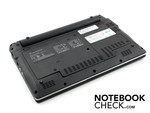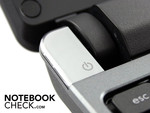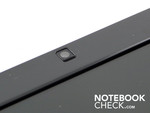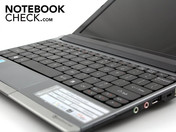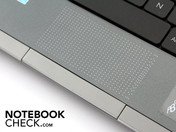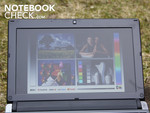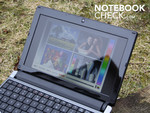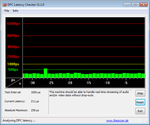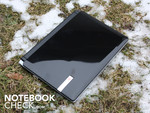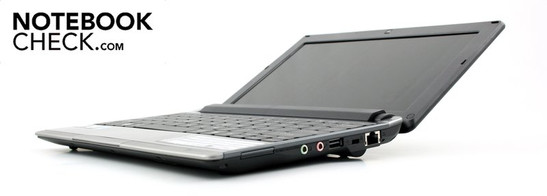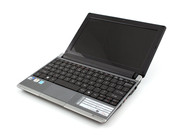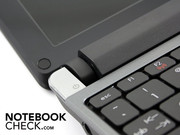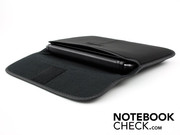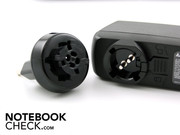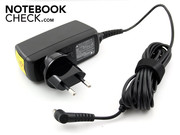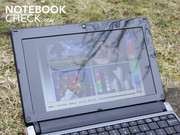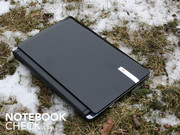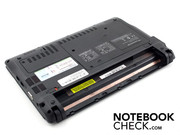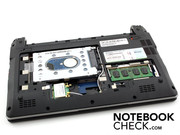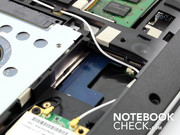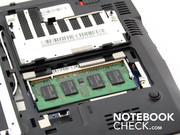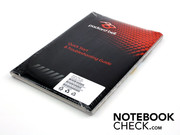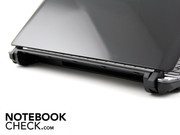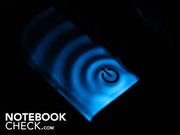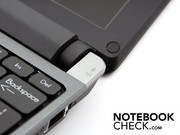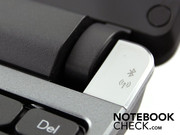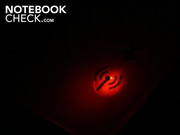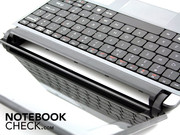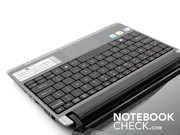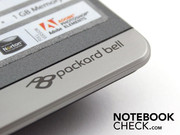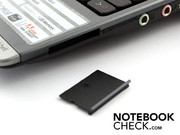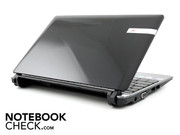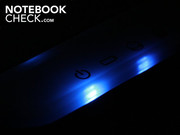Review Packard Bell Dot S2 Netbook
Those who want to attract attention with a netbook these days need striking colors, structured surfaces, an Nvidia Ion GPU or at least phat runtimes beyond the 10 hour mark. The Asus Eee PC Karim Rashid addresses the lifestyle division with its structured looks. The Dell Mini 1012 is aimed at entertainment fans with a Broadcom HD chip and the Asus Eee PC 1201 approaches the tech-fans among netbook users with an Ion chip set.
The Packard Bell Dot s2 at hand doesn't have any of these qualities. The 10 incher would like to be seen as an ordinary netbook for entertainment, for surfing and for mobile communication. For this, Packard Bell uses Intel's new Pine Trail platform with an Atom N450 processor. The connections are, as always, austere and the display isn't of the anti-reflective kind. With a battery life of 5:30 to 11:00 hours determined in the test, the s2 lasts for a long time without an outlet. We would like to fathom if the soft criteria like workmanship, waste heat or input devices provide reason for a rage.
Case
Packard Bell provides a solidly built netbook case. We especially like the stiff lid. We could pick the mini up at the edges or the upper corners. Nothing twisted. The lid's surface is sensitive to scratches, but it can only be dent with great pressure. The chassis is comparatively stable. We can only twist it with both hands and force. The battery fits very tight in its compartment and doesn't wobble. The base plate can only be depressed slightly in a few places and leaves a fairly superior impression, despite the plastic look.
The hinges move rather stiffly, but sit tight in their anchorage. Users will definitely need both hands to open it. The maximum opening angle has been chosen well. Even taller people can open the lid very far in order to adjust the display in an ideal viewing position.
Connectivity
Restrained but typically mobile - That describes the Dot s2's connections the best. On the right, in the Kensington lock's vicinity, we find the port for the network cable. The same side is finished with a cardreader in the front, as well as the headphone and microphone jack.
A small detail that we like: The 3.5 mm audio jacks for headphones, external loudspeakers or a microphone are reinforced by a metal ring. This almost excludes a breaking of the sockets. Most jacks are made completely of plastic. The USB ports don't have a charge function. The iPod or cell phone can, therefore, only be charged when the PC is running.
The case's left presents a VGA connection and two USB ports. The user can chain the mini to the table via Kensington lock. The included soft case has a slight cushioning for shocks and scratches. The flap has a slightly unfavorable cut and sticks out in a closed condition.
The inconspicuous VGA webcam supplies somewhat pallid but natural colors in indoor light conditions. The signal noise of the 640 x 480 pixel test images are surprisingly low. The fast adaption of changed light conditions is positive.
The manufacturer doesn't want to leave the user alone with its data chaos. If it has to be a netbook, then at least properly in sync with the PC - might be the motto. Packard Bell has installed a software suite for this. Automatic backups or synchronizations can be set up with it.
Input Devices
Keyboard
The keyboard doesn't belong to one of the highlights, but it's useable. The keys have a sufficient stroke length, but a slightly indistinct pressure point. The stroke is firm, especially because the keys sit tight on the entire surface. The keys only have a slight gap between them and usually a comparatively big surface. The small enter key proves to be less obstructive than anticipated in use. With the broad shift key, the hand can simply access the double occupied key above it.
However, the slight differentiation of the keys remains to be a flaw. In opposition to detached keys, the fingers can barely feel the junction to the neighboring key. A compromise in terms of keyboard quality is almost inevitable in a netbook, though.
Touchpad
The multi-touch pad from Alps has multi-touch functionality. Scrolling with two fingers or zooming by spreading of the same - Only these actions are possible with the mouse substitute. The pad's surface, sensitive up to its edges, has a barely palpable perforation. Because the pad is on the same level as the wrist-rest, typists can touch it unintentionally and trigger unwanted actions. The mouse substitute can be disabled via a function key in this case. The pad keys have a good stroke length but click unnecessarily loud.
Display
Packard Bell has never ever built in matt displays into its netbooks. This is not different in the Dot s2. A native resolution of 1024x600 pixels of the 10.1 inch WSVGA display is the current standard of mini notebooks. Low contrasts are, unfortunately, almost characteristic for the low-priced notebook class. We record 248:1 at a very high brightness of 256 cd/m2.
If such a low WSVGA resolution of 1024x600 pixels bothers you, you unfortunately can't force the display resolution to an interpolated, higher resolution. Thus, while looking at websites we often experience that we have to scroll a lot because the website is only displayed as a narrow stripe.
| |||||||||||||||||||||||||
Brightness Distribution: 89 %
Center on Battery: 248 cd/m²
Contrast: 181:1 (Black: 1.37 cd/m²)
The displayed screen's brightness doesn't have to hide with the achieved 256 cd/m2. That is a very high average rate, which even slightly surpasses the high brightness of the Samsung's N220. The illumination is extraordinarily homogeneous. The luminosity at the edges doesn't drop, it even increases.
Packard Bell builds in a glare-type display. Thus, a reflection weak surfing in sunlight is made impossible. The 10.1 inch screen meets its limits in blazing sunshine, despite its good brightness. If you look for a shadowy place or evade direct sun incidence, you can definitely work well on the go. However, you'll have to count with disturbing sources of varying light conditions in the train, during the car ride or on the camping site.
The Packard Bell Dot s2's viewing angles are good on the horizontal plane. Writing remains readable and colors are barely falsified up to about 50 degrees. But the image dims. Our eyes can stray up to 20 degrees before the image dims on the vertical plane. We experience extremely inverted color and a very dark display at a 45 degree deviation from above.
Performance
The Pine Trail netbook, Packard Bell Dot s2, is based on an Intel Atom N450 processor (1x1.66 GHz) with integrated GMA 3150 graphics. The processor has, as its Atom N270 and N280 predecessors, a small L2 cache of 512 KB. The performance data is basically on par with the Atom predecessor generation. Intel's hyperthreading technology makes a virtual core available for applications. Thus, the single-core can work with a multitasking OS, such as Windows 7 or XP, despite the weak clock rate.
The Atom N450 is supported by 1024 MB main memory and a 160 GB hard disk from Hitachi. The graphics, GMA3150, can borrow up to 256 MB from the RAM; the rest remains available for programs and operating systems.
Graphic performance is a foreign word for netbooks. This is also the case for the Dot s2. The DirectX-9 GPU (GMA 3150) is integrated into the processor and contributes just as little as its predecessors (GMA 950, GMA 500). The classic benchmark 3DMark2006, for example, finishes with 145 points.
Starter gaming notebooks with comparably weak dedicated graphic cards achieve 5000 to 6500 points in 3DMark2006. There is no HD support for the GPU. Result: The Dot s2 also inherits the flaw of the old netbook generation. 720p and 1080p encoded videos can't be played smoothly. But this isn't a tragedy because the 10.1 inch display can't present HD Ready anyway. Thus, YouTube clips or movies don't necessarily have to be played in HD on the Dot s2.
Packard Bell has installed a Windows 7 Starter 32 bit in order to make a low retail price possible. But no matter if with or without 64 bit, the synthetic processor benchmarks underline the Atom's N450 low performance. The Cinebench Multi CPU test merely achieves 859 points. Already a Pentium T4200 achieves 3489 points.
The application performance under Windows 7 is more important for a netbook. This doesn't appear to be particularly high. Directories, files or new programs first open with a noticeable delay. These delays become really evident as soon as programs run simultaneously. Listening to music with five browser tabs open and to type in the mail client at the same time? This scenario only works with frustrating delays.
That's not a real notebook feeling. But a Dot s2 doesn't have to accomplish this in order to meet its obligations. Mobility especially matters. Mobile surfing and checking emails always work. But the Packard Bell Dot s2 isn't a notebook replacement anyway.
| 3DMark 2001SE Standard | 2740 points | |
| 3DMark 05 Standard | 304 points | |
| 3DMark 06 Standard Score | 145 points | |
Help | ||
The Hitachi HDD (HTS545016B9A300) with a gross capacity of only 160 Gbytes reaches a weak data throughput in HDTune. 48.7 MB/s (Sequential Read Test) isn't up-to-date in 2.5 inch notebook hard disks. The HDD isn't audible even under profound reading and writing head activity. The hard disk can be easily replaced by a bigger one over the base plate. Users should however create a backup data carrier with the Packard Bell Software Suite prior to this.
Emissions
System Noise
One of Packard Bell Dot s2's advantages is its low system noise. A sound in use is frequently non-existent. The measured 29.5 dB (A) are produced only by the hard disk's gentle purring. Surfing in the web (flash animations) or playing music is already enough to activate the fan, though. But it isn't at all loud: 31.1 dB(A).
When the active fan really has to step on it, its level increases to merely 32.1 dB(A). We could only provoke this maximum volume in the stress test with Prime95, though. So there are only two levels of the active cooling: On and full speed.
Noise level
| Idle |
| 29.5 / 29.5 / 29.5 dB(A) |
| HDD |
| 29.7 dB(A) |
| Load |
| 31.1 / 32.1 dB(A) |
 | ||
30 dB silent 40 dB(A) audible 50 dB(A) loud |
||
min: | ||
Temperature
The temperature stays - no matter what we do with the s2 - on the floor. The highest waste heat that we can determine on the case is 43.3 degrees Celsius (bottom, louver vicinity). The Dot s2 has been put under processor load for two hours for this, though. The upper side's average temperature during the stress test is merely 27.5 degrees Celsius. The temperature at the processor reaches 61 degrees Celsius at most in the tests. A risk of overheating on the inside, as well as out, can be excluded.
If you're not planning to do any stress tests with the Packard Bell Dot s2, but only want to write emails or watch video clips, you can take delight in pleasant temperatures of circa 27.5 degrees (upper side).
(+) The maximum temperature on the upper side is 31.9 °C / 89 F, compared to the average of 33.1 °C / 92 F, ranging from 21.6 to 53.2 °C for the class Netbook.
(±) The bottom heats up to a maximum of 43.3 °C / 110 F, compared to the average of 36.6 °C / 98 F
(+) In idle usage, the average temperature for the upper side is 26.5 °C / 80 F, compared to the device average of 29.8 °C / 86 F.
(+) The palmrests and touchpad are cooler than skin temperature with a maximum of 31.9 °C / 89.4 F and are therefore cool to the touch.
(-) The average temperature of the palmrest area of similar devices was 29.3 °C / 84.7 F (-2.6 °C / -4.7 F).
The stereo loudspeakers, placed underneath the wrist-rest, supply a balanced sound for netbook standards. Due to the missing subwoofer, there are of course no basses. Trebles and midranges are emitted balanced, though. The small membranes don't start to scratch even at maximum volume. The hands on the wrist-rest only distort the sound slightly. However, the 10.1 incher has to be placed on a level surface. If a thick carpet or a blanket covers the loudspeakers, they naturally can't emit a balanced sound then.
Connecting external loudspeakers over the headphone-out is the tip for ambitioned music fans. We've tested this with two Yamaha speakers (YST-M20SDP). The netbook's tethered level is strong enough to allow even faintly amplified speakers to be turned up loud.
Battery Life
When the maximum possible energy savings measures are applied, the Dot s2 achieves a proud 11:00 hours. The PC bobbed along with disabled WLAN/Bluetooth and the lowest brightness setting in these 660 minutes. Thus, these 11 hours are an unrealistic specification (maximum possible runtime). The realistic battery life will likely be between 5 and 8 hours. The WLAN and DVD test are indicators for that.
How long will it last in WLAN surfing? The battery is drained after 5:37 hours because we visited news sites with lively flash animations. Video clips didn't belong to the test situation this time. The LED screen ran on a medium level during this, so a bit over 150 cd/m2.
Due to it lacking an optical drive, we've used an external USB drive for the DVD movie. It has its own power supply. The Dot s2 therefore only has to be on call for decoding the movie and operating the USB ports power. The movie first came to an end after 5:32 hours (342 minutes).
A low power consumption has always been the credo of the netbook category. Intel's Pine Trail platform provides the necessary requirements. The memory controller and graphic card are in the Atom processor, which reduces the power consumption and boosts the runtimes, as can be seen. It's remarkable that the Dot s2 reaches the runtimes above despite the fairly low battery capacity of 4400 mAh (48 Wh). The measurements of the average efficient power from the outlet (without battery) now show us why the runtimes are so good anyway.
The activated Dot s2 needs a minimum of 4.8 watts. When the brightness is maximized and the wireless modules are running, it's still even only 7.1 watts. If you put the Dot s2 under a real demand and both the hard disk and CPU have to work, you can boost the power requirement up to 14.1 watts (stress test plus graphic test).
Important for energy savers is also a low power consumption in standby and in a deactivated state. Our multimeter merely measured 0.3 watts (standby) and 0.4 watts (off). This hasn't been mixed up.
| Off / Standby | |
| Idle | |
| Load |
|
Key:
min: | |
Verdict
The Packard Bell Dot s2 retrieves many of the points that a netbook can seize nowadays. The solid case, the long battery life of 5 to 8 hours and the pleasant soundscape is worth mentioning. The input devices aren't perfect, as their keys are very close to each other. But a self test proves that you can work with them adequately.
The reflective 10.1 inch display is detrimental for the mobility claim. It's nice and bright but it can't stand up to reflections in direct sunlight.
The Packard Bell Dot s2 is available for starting at 299 euro in retail. The 160 GB hard disk isn't up-to-date but there is a Bluetooth module onboard and a Mini PCI ExpressCard slot is ready for any upgrades. Windows 7 is the bargain. Buyers who are looking for a good netbook with a long battery life and low weight can't do much wrong with the Packard Bell Dot s2. Potential buyers just shouldn't expect performance. The Dot s2 is a netbook for a mobile internet visit and checking emails.





